Types of weaving/ types of loom 3 : yarn heddles, cards
The advantage of doing each under and over weaving move separately is you have complete freedom about the texture and colour of patterns you make. But it’s very slow as each over and under is done by hand. Explains why tapestries and tufted rugs take a long time to make and are very expensive.
(Previous posts in this group :
1. simplest weaving
2. frame looms)
Next step – big advance in technology – devise a way of holding the warp threads so the weft thread can go all the way across in one pass.
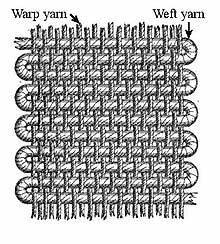 Wikipedia
Wikipedia
This is ‘plain’ weave, often called ‘tabby’.
To make this simple weave, you need a way to hold alternate warp threads up, so there’s a gap between them and the others. Then you can pass the weft through the gap between them.
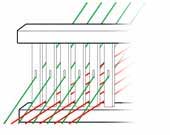
picture source
This triangle shaped gap bewteen the warps is called the ‘shed’. (So a weaving shed is not necessarily the building the loom is in. . .)
The devices holding the warp threads are called ‘heddles’ (the drawing shows a ‘rigid heddle’, there are other types).
Then you need a way of swopping the warp threads round, so that the ones which were up are now down, and vice versa.
And you need a way of supporting the weft yarn so it’s easy to ‘throw’ it through the shed. That’s done by winding the weft yarn onto a shuttle.
This post is about the simplest methods of holding warp threads. Again it’s possible to use simple methods to make complex patterns. But it’s still a relatively slow process. For “better“ ways of speeding up see the final paragraph. Better in the sense of quicker to make cloth, but it may be more difficult to make complex patterns.
I’ve picked out a few videos and books on these simple looms. You can find a huge amount of information and advice on-line, and people who supply all sorts of gizmos and yarns.
– – –
Shed stick, yarn heddle, heddle stick/ harness.
Set up your frame loom with warp threads.
Cut a ‘shed stick’ from cardboard, longer than the width of the warp threads, and 1 to 1-1/2 inches (3 – 4 cm) wide.
Thread this over and under the warp threads.
Turn it on it’s edge, and you have made a ‘shed’ gap which you can pass a shuttle of weft yarn through.
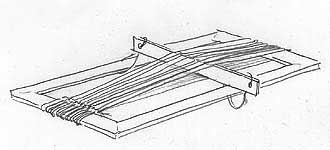
picture source
Ah, but how to get back the other way, when you need the other warps raised to make the ‘shed’ the other way round.
Well, before starting the weaving, lay the shed stick flat.
Cut lengths of yarn, about 10 inch/ 25 cm.
Tie one of these leash or ‘heddle’ strands round each of the warp threads not lifted by the shed stick.
Loop the string heddles round a ‘heddle stick’, also called a ‘harness’.
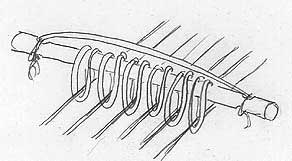
picture source
To weave, turn the shed stick on edge to make the shed, and pass the shuttle through.
Then lay the shed stick flat, and use the heddle stick to pull up the other warp threads, so you can pass the weft thread under them in the other direction.
These diagrams come from an excellent article with all the details.
Another way of working is to have yarn heddles on all the warp yarns (no shed stick). Then you can lift up the warp threads individually or in groups, whichever you like.
In this video the weaver uses sticks to pick up the warps she wants to use. Then when all the heddles are made, she ties them together into 3 groups, for the 3 different lines of the weaving pattern. When you have a separate heddle on each warp strand and use them individually, things can get quite complex and ingenious !
– – –
Longer warps
Those looms set up the warp threads on a frame, which limits the size of the area you can weave. How to get longer warps ?
– tie one end round your waist and the other round your toes.
– tie one end round your waist and the other round a tree.
This is the next big step in weaving technology.
There are many varieties of this sort of loom, thought up by different cultures. Have a good search if you’re interested. There are DVDs on ethnic weaving methods, general surveys and individual studies. And ‘The Book of Looms’, which is about weaving traditions around the World.
If you’d like to try one of these, here’s an excellent source on making and using a backstrap loom.
And here’s some of what she makes :

Handwoven magazine November 2010 page 18
Excellent examples of the complex patterns you can make when you control individual heddles, slow but effective.
Those looms are very portable. But I’m just going to talk about looms that are not attached to the weaver !
– – –
Inkle loom
On an Inkle loom, the warps are wound round a frame, which sets the length of warp. Inkle looms make 2 or 4 inch (5 or 10 cm) width strips, so they’re good for making flat braid with a firm weave.
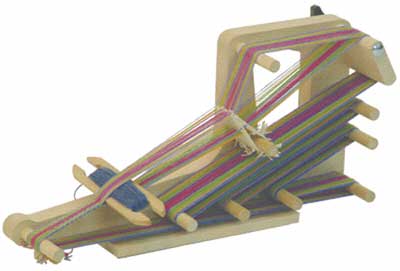
picture source (weaving looms, page 2)
Here’s a good video showing how to use this sort of loom. Yarn heddles (lightest colour in the photo) hold alternate warp threads in a fixed position, and the other warp threads are moved above or below them by hand.
Excellent for making firm braid, and no shortage of things to do with it :
sadly site on 75 things to do with braids no longer (2018) exists.
book : Inkle Weaving by Helene Bress (2018 – oop)
– – –
Card weaving
Tablet weaving
Inkle looms can basically only make the simplest plain weave.
But there are ways of leading the warp yarns through holes in cards. The ways the cards are threaded, and then how the cards are turned during weaving, make different weave patterns.
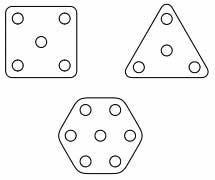 Wikipedia
Wikipedia
Here’s a video example of card weaving
I can see why people find this fascinating, but I don’t think I would find it restful to do ! No doubt it gets easier with practice.
Much loved by Viking and mediaeval re-enactors, so people tend to make their own looms. . . You can buy ready made cards (also called tablets). And you can buy looms. Here is one :
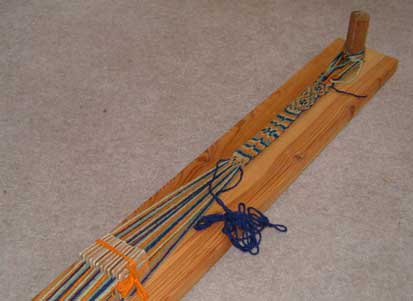
picture source (Board for Tablet/ Card weaving)
This loom is 2 yards (1.8 m) long – no problems with warping up !
Using cards on an inkle loom is called tablet weaving.
book : ‘Card Weaving’ by Candace Crockett
– – –
No shortage of fun ways of weaving without making an investment in the complex mechanisms of a big loom.
– – –
P.S. here’s a very basic ‘loom’ for card weaving.
And here’s a simple piece on a backstrap loom.
– – –
Links and videos available November 2010
– – –
Note in 2013 : I was going to write a final piece in this group, about rigid heddle weaving and floor looms. But it isn’t necessary – there’s no shortage of internet advice on them.
They’re both ‘beam’ looms, a technical advance which allows you to make a long length of cloth (the warps are wound onto the beam).
The difference between the two is in the heddles.
Many weaving sources which claim to be complete actually only mention floor looms.
A ‘rigid heddle’ moves all alternate warp threads together. Weaving with one of these is often dismissed as not ‘real weaving’. But it’s a good type of weaving to have as a hobby. A fun way of learning the basics. Interesting in its own right as you can make (slowly) many textures. You can weave wide enough fabric to use for making clothes, though rigid heddle looms big enough for that are quite large.
Floor looms have another technical advance – each warp is in an individual heddle, which is held in a frame called a ‘shaft’. Any floor loom is quite large (I knew someone who had one made from tree trunks – you need a barn for those). But there are smaller looms called ‘table looms’ which use the same shaft mechanism. The heddles are threaded in groups – each group in its own shaft. An easy way of making some though not all textures/patterns. The more shafts the loom has, the more textures you can make. And the more difficult it is to learn. Another advance which has high pay-offs in the ease of doing some things, but other things become impossible (compared, say, with a backstrap loom). Unless you have a computer-controlled loom which can alter individual heddles.
There are introductory video classes on both these loom types at Craftsy.
= = =
Explore posts in the same categories: weaving
November 29, 2010 at 4:05 pm
Believe it or not, the card weaving is very fun to do … It’s relaxing and very rythmic — not at all stress-inducing. I’ve made some trim using this method with regular embroidery floss and it turned out really nicely. I made a key fob/lanyard from it.
November 29, 2010 at 6:59 pm
Thanks for the comment Ginger – you’ve convinced me to try it 😀